Inserting Multimedia Objects
|
| < Day Day Up > |
|
Up to this point in the chapter, you've learned about adding images to Word documents. But did you know that you can use Word to communicate using more than words and pictures? Your Word documents can literally sing, if you choose to add audio clips or voiceovers. They can show something in action, if you choose to add a video segment. Your Web pages can teach, if you want to add a PowerPoint presentation to the page you create in Word.
Word makes it easy to both link and embed files (which are called objects for this operation). That means you can work with files you create in other programs, whether they're programs in the Microsoft Office System or not. This next part of the chapter shows you how to incorporate objects in your documents, whether you want to add multimedia effects or something more sedate, like an Excel spreadsheet or a bit of Access data.
What kinds of things might you want to link? You've got all sorts of choices: a sound file, a table, a video clip, an equation, data tables, images, a presentation file, or another Word document.
Create It Once, Use It Again
One of the great things about using a multi-application system like Office is the way you can reuse what you create. You can open your Excel spreadsheet in your sales report. You can attach an organization chart to the announcement of the new spring promotions. You can add a voiceover segment to a section of a speech you're testing with your coworkers. You can use these different items in your Word document by importing them as objects.
Although you can copy and paste these items into a document, keeping the data current can be a problem if your information changes often. If you paste a segment of your Excel worksheet in your document, and then the original worksheet changes, your document will be out of date. To create multidimensional documents and keep them current, you can link the objects to their original files using object linking and embedding (OLE) and Dynamic Data Exchange (DDE).
| Note | You can import objects from programs outside the Microsoft Office System. As long as a program supports OLE and DDE, you can link and edit that program's objects. |
Linking vs. Embedding: A Comparison
Linking a file and embedding a file might seem like the same process. In fact, they are two very different processes, each providing a different function, as follows:
-
Linking Establishes a link between the original (source) file and the file to which you copied the data (destination). Whenever you change the information in the source file, the destination file is updated.
-
Embedding Places an intact copy of the source file in the destination file. Although changing the source file doesn't affect the destination file, you can edit the object in the destination file by double-clicking it. You can then edit the object without quitting Word.
Tip Cut to the chase The biggest difference between linking and embedding is which file (source or destination) contains the data and how this file is updated (at the source, or originating program, or in the destination document).
Good Candidates for Linking and Embedding
Linking an object is a good choice when you need to keep data in your documents up to date. Here are a few examples:
-
You're creating a draft of a report that includes slides from a PowerPoint presentation that's not yet finished. If the document is linked to the presentation file, when you finish the presentation, the document will reflect the changes.
-
You have a new logo design for your business, and you're trying it out on letterhead. If you maintain the link to the draw file in which the logo is stored, when you change the logo, the letterhead will reflect the changes.
-
You have a sales report due this afternoon, but not all the numbers are in from your regional sales staff. If you import the part of the Excel spreadsheet that's ready and establish a link when you update the information later, the file will reflect the changes.
Embedding objects is a good idea when you don't need to maintain a link but want to edit the object in your document. Here are some examples of embedding:
-
You want to send a snapshot of current Excel data to a coworker, but the information is likely to change.
-
You want to add a finished spreadsheet object. You don't need to maintain the link, but you might want to change the format or values later.
-
You've added an organization chart, but when you send the document to different audiences, you need to change the roles that are displayed.
Note Linking an object to a file establishes a one-way link to the source document. When you change the information in the source—for example, when you change the name of a product in the PowerPoint presentation you've imported—the same change is reflected in the document to which you've linked the information.
Tip Use linking to minimize file size When you want to keep your files small, linking is your best bet. Because a linked file stores only a pointer to the source file, the destination file size increases only a little. Although these types of links introduce other potential problems (such as broken links to deleted or moved source files), they give you the flexibility you might need when size is a consideration.
Linking Objects
Word provides two different ways for you to bring linked objects into your documents. You can use the Insert Object dialog box to place an existing object in your document, and you can use the Paste Special command to use the basic copy-and-paste procedure to establish and maintain a link with the source file.
Inserting a Linked Object
Suppose you have a great new banner ad design that you want to incorporate in the document you're preparing for a client. Although the banner ad isn't quite finished, you want to show the client how the ideas are developing in the presentation. You decide to add the entire presentation to your document as a link in the report.
To insert the object and create a link to the source file, follow these steps:
-
Place the insertion point where you want to include the object.
-
Choose Insert, Object. The Object dialog box appears.
-
Click the Create From File tab, as shown in Figure 11-21. Here you can enter the name for the file you want to insert and choose whether to link or embed the file.
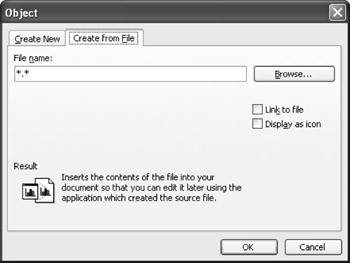
Figure 11-21: The Object dialog box gives you the means to link or embed objects. -
Click Browse. The Browse dialog box appears. Navigate to the folder in which the file you want to link is stored, select the file, and then click Insert. You are returned to the Object dialog box.
-
Select the Link To File check box. This tells Word to establish the link to the source.
-
Click OK. The object is inserted at the insertion point.
Tip Run a presentation If your linked object is a PowerPoint presentation, run the presentation by double-clicking it. You won't be able to edit the presentation, however, without opening the source file.
Troubleshooting: The linked object is missing
So after you go through the steps to insert a linked object, it starts to appear in your file and then—nothing. Just an outline, no object. What's going on?
If you have enabled Picture Placeholders in the Options dialog box, Word is saving memory and screen update time by showing only the outline of the object. You can fix this by choosing Tools, Options, and then clearing the Picture Placeholders check box in the Show section of the View tab.
| Tip | Create objects with Create New The process of embedding uses the Create New tab in the Object dialog box. Embedding an object enables you to include in your document objects you have created in other programs, and it also lets you actually create the objects from scratch while you are working with Word. When you select the options in the Create New tab to create an embedded object, Word launches the program you used to create the object; after you save and close the other program, you are returned to Word, and the object is embedded in your current document. |
Adding Linked Objects with Paste Special
Another way to add a linked object to your document is to use Paste Special. This command (available from the Edit menu) copies and pastes not only the data but also a link to the source file. Start in the Word document to which you want to add the linked object, and then follow these steps:
-
Position the insertion point where you want to add the object.
-
Start the program in which you have created the object. Select the section or object, and then copy the item to the Clipboard.
-
Return to Word, and then choose Edit, Paste Special. The Paste Special dialog box appears, as shown in Figure 11-22.
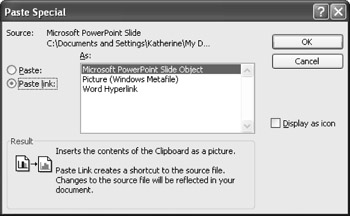
Figure 11-22: The Paste Special dialog box enables you to both link and embed data. -
Click the Paste Link option, select the object type in the As list box, and then click OK. Word adds the data and the link to your document.
Note The Paste Link option is available only for objects you've created in programs that support linking.
Note When you want to review the links in your current document, choose Edit, Links to display the Links dialog box.
Changing Linked Objects
Any editing you do on a linked object actually takes place in the source file. You can edit a linked object in several different ways:
-
You can double-click the object to launch the source program.
-
You can click the object, choose Edit, Linked Object, and then click Edit Link.
-
You can right-click the object to display the shortcut menu. You can then click Linked Object and select Edit Link. This takes you to the source file so that you can make changes, as shown below.
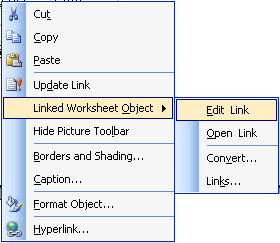
To modify the source object directly, make your changes in the originating program. Save and close the object as you would normally.
When you return to the linked document, select the linked object and choose Edit, Update Link (or press F9). Depending on how you've set up your options for updates, the destination file might be updated as soon as you return to it or it might be delayed until you manually choose an update.
Working with Links
The only tricky part to working with linked objects in your documents is that managing a variety of links can be confusing and a drain on your system's resources. For this reason, Word pulls link management together in one place—the Links dialog box, shown in Figure 11-23. To display this box, choose Edit, Links.
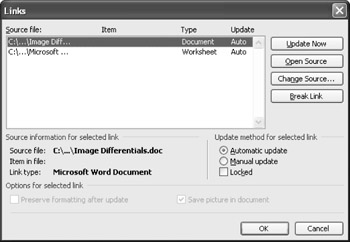
Figure 11-23: The Links dialog box gives you the means to review, change, update, and remove links to objects you've inserted in your document.
The following list provides you with a quick overview of the techniques you'll use to keep your links in order.
-
Reviewing links In the Source File list of the Links dialog box, you see a list of the currently active links in your document. The information tells you the type of link, the update method (Auto is selected by default), and any options that have been selected.
-
Updating links By default, Word updates any links in your document. Each time you open the file, Word checks whether any links have changed—a process that can take a few minutes if you've added many links to your current document. Similarly, when you make a change to the source file and the destination file happens to be open, Word updates the destination file if you've set the updating options to update automatically.
-
Manually updating links If you want to update links manually, display the Links dialog box, select the link you want to change, click the Manual Update check box (under Update Methods), and then click OK. When you want to update the link, press F9.
-
Locking a link To lock a link, display the Links dialog box, select the linked object in the Source File list, and then select the Locked check box in the Update Method For Selected Link section. You can unlock a link later if you choose by repeating the first two steps, and then clearing the Locked check box.
-
Going to the source When you want to look at the source file for your document, you can use the Open Source button in the Links dialog box to get to it. Simply select the link in the Source File list, and then click Open Source. The source program runs, and the file appears.
-
Changing the source When you move a source file, the linked document needs to know about the move. To update the linked document about the source's new location, choose Edit, Links, and then, with the link selected, click Change Source in the Links dialog box. The Change Source dialog box appears. Navigate to the folder where the source file is now located, click the file, and then click Open. Click OK to close the Links dialog box.
-
Breaking links When you have a file in its finished state, you might want to break a link to protect the object from future modifications. To break the link of a selected object, click the link in the Source File list in the Links dialog box. Click Break Link, and then click Yes to confirm.
Tip Update now It's possible for some links in the Source File list in the Links dialog box to show Auto updates and others to show Manual updates. You can force the update of a Manual link by selecting it in the Source File list, and then clicking Update Now.
Troubleshooting: My changes are lost
If Word crashes and then AutoRecover restores your document, you might find that your linked object has lost its most recent changes and is appearing as an outline instead of a fully displayed object. To fix these problems, save the document, click the object, and then choose Tools, Options. Clear the Picture Placeholders check box in the Show section of the View tab, and then click OK to close the dialog box. Then, with the object still selected, press F9 to force a manual update. Word compares the object to the source file and updates any missing changes.
| Note | If you want to reestablish the link you just broke, pressing Ctrl+Z does the trick. |
Embedding Objects
Embedding objects, in contrast to linking objects, is a pretty straightforward process. There are no links to worry about or maintain. You simply place an object in the document and there it stays. Pretty clean and simple.
The downside of embedded objects is the size of the file they create. When you add a PowerPoint presentation to your destination document, for example, your Word file takes on the weight of the additional file. With a linked file, only the link to the source file is actually stored in the document.
Pasting Data as an Embedded Object
When you want to embed a portion of a file, you can use Paste Special to import the information, keeping the formatting intact. Select the data you want to embed, and then copy it to the Clipboard. Open your destination document, and place the insertion point where you want to add the data. Choose Edit, Paste Special to display the Paste Special dialog box shown previously in Figure 11-22. Choose the format in the displayed list, and then click OK to embed the data.
Creating a New Embedded Object
To create a new embedded object, start in the document to which you want to add the embedded object. Place the insertion point where you want to add the object, and then choose Insert, Object. The Insert Object dialog box appears, with the Create New tab selected, as shown in Figure 11-24.
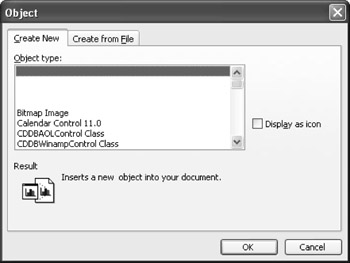
Figure 11-24: You can create an embedded object from within your Word document.
Scroll through the Object Type list, and select the one you want. If you want to have the embedded object displayed as an icon instead of a file, select the Display As Icon check box; and then click OK. The program that creates the object you selected launches so that you can create the item for your Word document. When you're finished creating the document, choose the File menu, and then choose the command that enables you to return to Word.
| Note | Depending on the program you're using to create the embedded object, the menus you see might differ from the ones you see here. Different programs offer different levels of support for object linking and embedding. If you need help with the program you're using to create the embedded object, consult that program's help system or your program documentation. |
Adding an Existing Object
Adding a file or data section to your document as an embedded object allows you to keep all the data in one place, which makes your file portable. The benefit of embedding a file as opposed to copying it into your document is that you can edit an embedded object—in its originating program—from within your Word document. To add a file as an embedded object, click the spot where you want to add the object, and then choose Insert, Object. Click the Create From File tab, choose Browse, select the file you want to embed, and click Insert. Click OK to add the object.
Editing an Embedded Object
You edit an embedded object by double-clicking it—whether the object is a section of a file or an entire embedded file. Double-clicking starts the program in which the file was created. You can make your changes as needed, and then choose File, Close And Return To Microsoft Word to accept the changes in your document.
Troubleshooting: I can't edit an embedded object
You double-click an object to edit it, and nothing happens. What's going on? These are the possibilities:
-
Make sure the source program is still installed. If it's not, install it or convert the embedded object to a file format you can use.
-
Make sure that you're not running low on system memory. If that appears to be the problem, close all other programs to free up resources.
-
If you're working with a linked object on a network, make sure that no one else has the source file open at the same time, or that the network location still exists.
-
Make sure that the source file hasn't been moved or renamed. Check this by clicking the object and choosing Edit, Links.
|
| < Day Day Up > |
|
EAN: 2147483647
Pages: 373